By Gary Hoover — February 27, 2019
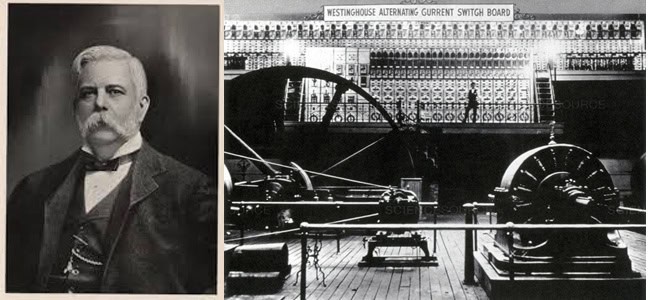
His father owned a machine shop, but young George Westinghouse had no interest in doing what he was told. Obsessed with his own inventions and ideas, George earned his first patent at the age of nineteen. When he died forty-eight years later, he held over four hundred patents—granted one on average every six weeks throughout his life—and was working on an electric wheelchair idea. Like Thomas Edison, Westinghouse was a prolific inventor, but unlike Edison he successfully built and ran multiple great enterprises employing tens of thousands of workers. Those workers were treated better than at almost any other industrial employer of the era. His companies registered over one thousand patents. George Westinghouse always dreamed big and acted boldly, focused on the biggest issues in technology, attributes seen again today in dreamers like Elon Musk. This is his story.
Beginnings
George Westinghouse, Sr. (the father), was born in Vermont and migrated to upstate New York with his wife, Emmeline. After starting out as a farmer, he invented and patented improvements in threshing machines. After three sons and three daughters, their seventh child, George, Jr., was born in Central Bridge, New York, on October 6, 1846. The father soon started a machine shop and in 1856 moved to the larger town of Schenectady in order to be closer to his suppliers of iron parts.
While his older brothers obediently worked in the machine shop, young George proved problematic. When he didn’t get his way, he screamed and hollered. He later commented, “I have always known what I wanted, and how to get it. As a child, I got it by tantrums; in mature years, by hard work.”
Nevertheless, he showed early signs of being a perfectionist. As his father was whipping him for some misdeed, his father’s punishing switch broke. Though crying, the little boy pointed to a leather whip on the wall, saying, “There’s a better one, Father.
When George (the son) was given a job in the expanding machine shop, his mind drifted away to his own ideas and inventions. His father called his collection of incomplete machines “trumpery.” But a foreman took a liking to the boy and set him up in his own secret shop in the attic where George toyed with the idea of a rotary engine, an idea he never let go of.
In school, teachers called George “inept” and “languid.” The textbooks bored him. Penmanship, spelling, and grammar were “a deadly burden,” but he loved math and was the best draftsman in the class, continually drawing locomotives and engines.
When, at the age of thirteen, his father berated him for wasting time, unlike the other workers, George protested, “But they get paid for their time.” His father, who considered play as “idleness,” started paying him fifty cents a day, hoping to instill a work ethic in the child. When George said he was taking off work to play with friends, his father sternly informed him that they had a deal and that he needed to cut some metal pipes. George rigged up a machine to do the task and took off with his friends.
Despairing about the boy’s future, his father asked his minister for advice. The minister told the father, “He isn’t the kind of boy you can shape against his will.” So his father began to give George more leeway. But George continued to “waste” his time on toys, building a working boat with an engine of his own design.
As the Civil War began, his friends and older brothers got the urge to join the fight, despite their father’s protests (and hope that the war would soon end). At fourteen, George ran away and jumped on a train headed for the battlefields, but his father got word, caught the train, and whisked George off the train just before it departed. In 1862, the father relented and let two of George’s older brothers go to war—one never returned, dying in battle in Louisiana. By 1863, his father permitted the now seventeen-year-old George to join the war effort. After a stint in the army, George moved to the navy, where he served as “Acting Third Assistant Engineer,” running and maintaining the engines on two ships. He gained some discipline and a great deal of knowledge about marine engines, continuing to develop new models and ideas while in the service.
When the war ended, in September of 1865, his father enrolled George in Union College in Schenectady. But he skipped classes to go see the latest machines in nearby shops. By Christmas, he had dropped out. That October, nineteen-year-old George registered his first patent, for a rotary steam engine. He was now making two dollars a day working for his father.
Entering the Railway Supply Business
On the way home from business in Albany, George’s train was delayed for hours when two cars in the train ahead derailed. As he watched the workmen lift the cars back onto the track, he turned to a fellow traveler and said, “That was a poorly handled job.” The other replied, “But that could not be helped,” to which George answered, “Yes, it could.” He then invented a “car replacer” device and patented it with $10,000 raised from local investors (his father was skeptical and invested little).
As George sold his car replacer to the railroads—at the time America’s most important industry—he learned much about trains and how they work. He saw plenty of opportunity to do things better. One was the “frog,” the moving parts of the track used to switch trains from one line to another. Made of cast iron, frogs were neither reliable nor durable, requiring constant repairs. George used the less common technology of cast steel to make a better frog and patented it in 1868.
Riding a train in 1867, he met beautiful Marguerite Erskine Walker and immediately fell in love with her. By August, they were married. Throughout their forty-seven-year marriage, virtually every day when they were apart, George telegraphed or telephoned her. They eventually had one son, George Westinghouse III.
As Westinghouse’s small company continued to improve on his car replacer and cast steel frogs, he observed the railroads making their own changes, avoiding his patents. Thus he began a lifelong tradition of not only defending his own patents, but also buying up the patents of others when he sensed opportunity. Westinghouse also gradually surrounded himself with the best minds and engineers he could find. He was a demanding but compassionate leader, often working alongside the craftsmen as they worked to improve upon every product.
The Air Brake
Braking a train was one of the most dangerous jobs in America. Most trains were only ten cars or less in length, with a brakeman stationed every two cars, perilously riding on the tops of the cars. When the engineer gave the whistle to brake, they jumped down between two cars, turned the giant wheel on the car in front of them to set its brakes, then turned the wheel on the car behind them. The cars gradually came to a stop, bumping into each other and knocking passengers or freight around. Brakemen often fell between or under the cars, losing limb or life. Here George saw a big opportunity.
For months, George tried every possible idea. First were repeated attempts to rig up a chain system that ran under the length of the train. All failed. Then came the idea of using the locomotive’s steam to brake the cars, but the steam evaporated before it reached the last car.
One day a young woman tried selling a magazine subscription to George, but he was not interested—until he saw an article in her sample copy about the construction of a new tunnel between France and Italy. He signed up for a subscription and convinced the woman to give him her sample copy. In it, he discovered the Italians were experimenting with a new way to safely bore through a mountain, using compressed air to drive the hammers. That was his big “aha” moment.
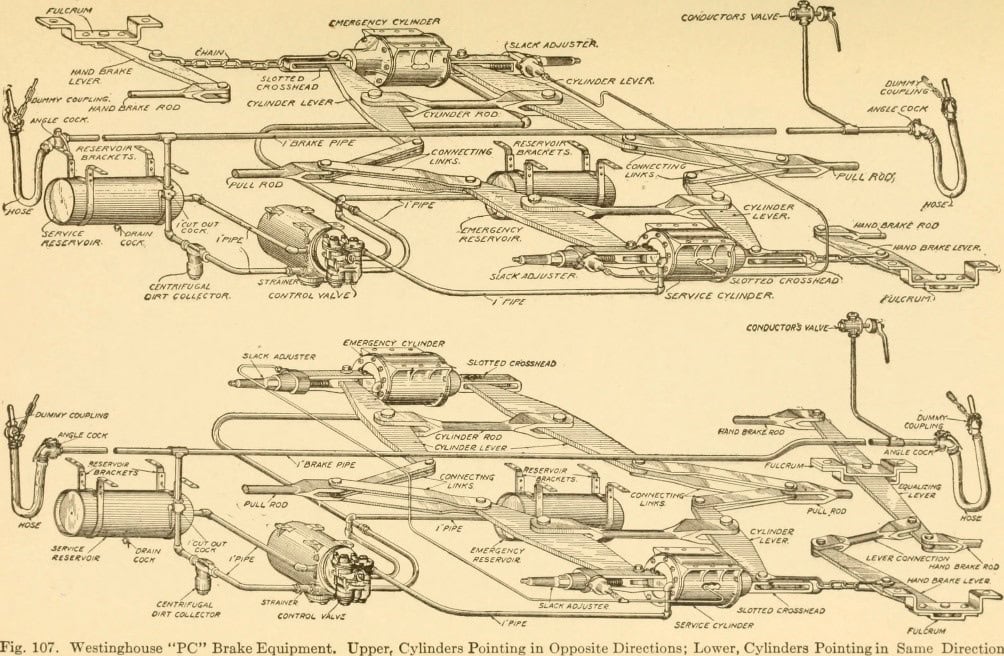
Hell-bent on solving the braking problem, George experimented with a line of compressed air running the length of the train. Early efforts were not promising, as the last cars in a train jarred the first ones when the brakes were applied. But when George got his mind set on something, he would not let go. By putting smaller air reservoirs on each car, controlled by a main compressed air line, he gradually reached the point where the entire train stopped within seconds of the engineer throwing a switch. Lives could be saved, trains could be longer, and passengers and freight more gently handled
George and his backers went from railroad to railroad, only to be rebuffed. People were happy with things as they were, despite all the drawbacks. Every “expert” said Westinghouse’s system would not work. After many unsuccessful sales calls, the most powerful railroad in the land, the Pennsylvania Railroad, agreed to a test. Upon its success, a young executive of

In 1869, at the age of twenty-three, George Westinghouse
George was convinced that the entire world needed his invention. With great effort, he convinced the British to try it. He was among the earliest American industrialists to establish branch offices and sometimes factories around the globe. By 1881, the system was in use on sixteen thousand cars and locomotives in the United States and over twenty thousand in other nations.
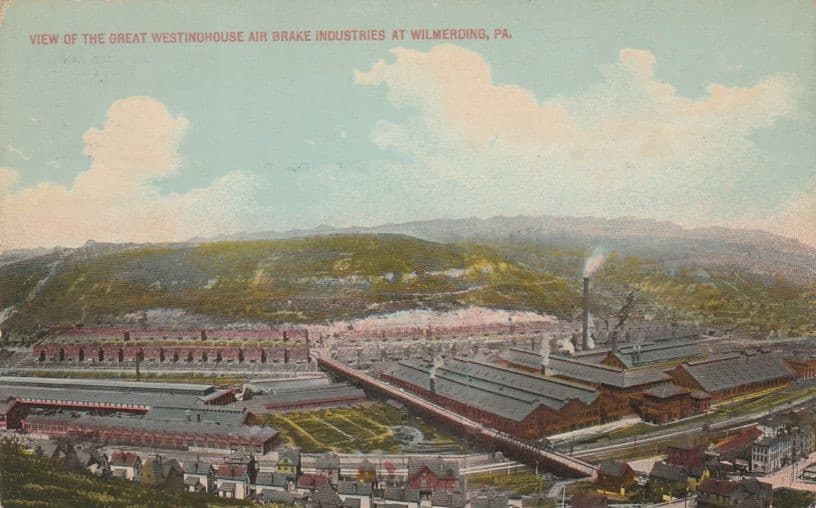

Westinghouse’s controlling ownership of the company made George a wealthy man. Its work continues into the twenty-first century as Wabtec, a major transportation supplier. (In 2018, Wabtec agreed to acquire the diesel-electric locomotive manufacturing business of General Electric, one of the largest global producers.)
Broadening Horizons
By the early 1880s, George had become interested in the switching and signaling systems used by the railroads. He made significant improvements and filed patents. In 1881, he incorporated the Union Switch & Signal Company, which became the largest producer of such equipment. This business led George to study electricity, using it in Union’s products. (Today, Union is part of the Italian company Ansaldo STS, which in turn is controlled by the Japanese Hitachi company.)
In the mid-1880s, natural gas was found in Murrysville, Pennsylvania, twenty miles from Pittsburgh. While local gas companies provided street lighting, they had no means by which to move gas such long distances. George became interested in the challenge of “gas transmission.” Failing to interest others, he drilled a well in the backyard of his Pittsburgh estate, which his wife, Marguerite, had named “Solitude” because it was supposed to give George a break from his work. But that was not to be. George’s well struck gas, causing an explosion that shook the neighborhood.
Continuing the work on the transmission problem, he figured out how to move gas under pressure over longer distances. He wanted to get gas to Pittsburgh’s homes and industries—it was cheaper and cleaner than the coal
Building these successful enterprises did not fully consume George’s drive and curiosity. His most impressive work was yet to come.
The Current Wars
George had organized the Westinghouse Machine Company in 1880 to build engines to power arc lighting systems, which were the main way city streets were lit. This system was replaced by the Direct Current (DC) electrical generation and distribution system of Thomas Edison, which used the smaller, less-intense incandescent lights. In 1886, the forty-year-old Westinghouse created yet another corporate entity, the Westinghouse Electric Company, and began to manufacture DC systems. Within two years, this company had over three thousand employees. George’s curiosity about and knowledge of electricity had grown dramatically since his creation of Union Switch & Signal.
Thomas Edison had achieved international fame with his DC system. With it, individual factories, homes, and offices could be lit with incandescent lighting. Yet there were limitations. Because of the nature of DC, a generating station could only serve about one square mile of customers. Any further reach required a prohibitive investment in large-diameter copper wires. There was no way to transmit DC power over long distances. But Edison remained firm in his belief that direct current was the only way to give the world accessible electricity.
At the same time, experimenters in Europe were toying with the idea of Alternating Current (AC), a different approach to the problem. With the right transformers, the voltage of AC could be “stepped up” to extremely high voltages and carried over longer distances, before being “stepped down” in transformers near the factories and homes that might use it. Such high AC voltages were more dangerous than DC, and many kinks in the AC system were yet to be worked out, including the invention of a motor for factory and shop power that worked on AC. The greatest electrical engineers of the world—then called “electricians”—all agreed that AC would never work, with Edison leading the charge. His Edison General Electric Company had installed his DC system in cities across America. (Edison General Electric was later merged into the General Electric Company we know today.) Into this story steps the brilliant and eccentric Serbian-American engineer Nikola Tesla, an advocate of AC despite all the opposition. Through a lifetime of invention and a sense of showmanship, Tesla made progress on AC and came to the attention of Westinghouse. George backed his experiments, had him visit Pittsburgh, and bought Tesla’s AC patents with a generous offer of royalties.
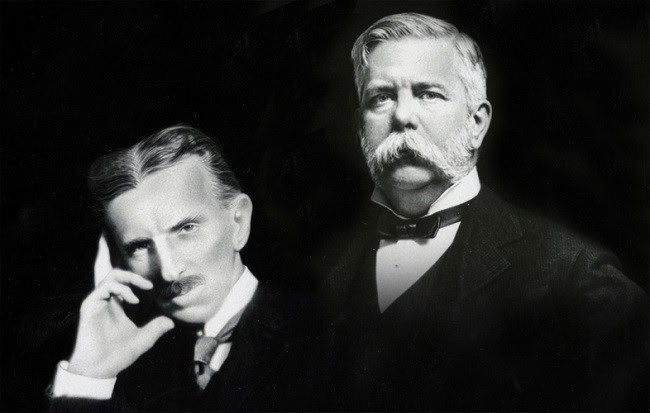
The collaboration of Westinghouse and Tesla set the stage for a great battle among experts and users as to the trade-offs between AC and DC, known as the Current Wars. Tests were held around the nation and in Europe. Newspaper editorials raged against AC. Edison was committed to defeating AC, leading a massive publicity campaign. His primary tactic was to show how dangerous AC power was. In public demonstrations, AC power was used to electrocute dogs. When New York State changed the death sentence from hanging to the electric chair, AC power was used. Edison called it “the Westinghouse chair,” hoping to further discredit his rival and Tesla.
Edison also controlled all the patents on incandescent electric light bulbs—then called “lamps.” Westinghouse had to invent his own “stopper lamp” in order to compete and avoid patent infringement. Yet over time, as Westinghouse, Tesla, and their fellow engineers worked through all the problems, AC won out and gradually replaced DC everywhere. Edison had lost. The Westinghouse Electric Company went on to become the largest and most important of the many companies George Westinghouse founded and ran. Westinghouse systems were installed around the globe, from Europe to Canton, China. George’s ability to continue inventing and working in the shop at the same time he administered thousands of employees was remarkable, perhaps unique in his era.
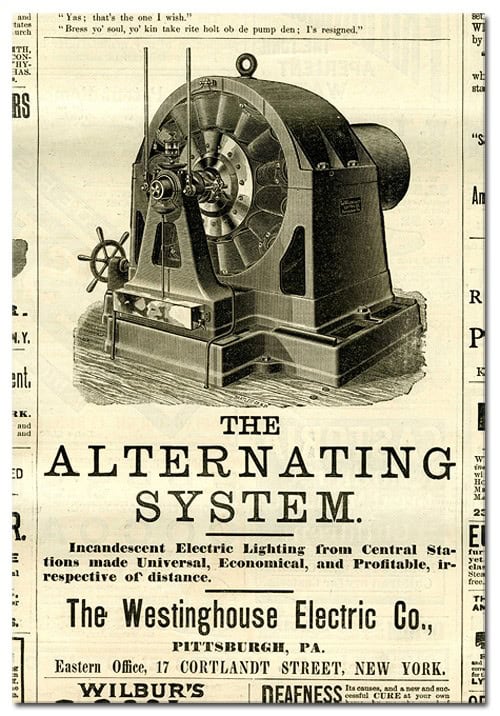
Now an industrial baron, Westinghouse befriended everyone from presidents to up-and-coming inventors, whom he liberally sponsored, buying more patents. He established a winter home in Washington DC and a summer retreat in Massachusetts. He traveled everywhere east of Chicago in his luxurious private railway car, the Glen Eyre.
A Close Call
In 1890, the British Baring Brothers’ bank collapsed, and credit dried up on both sides of the Atlantic. With his electric company growing like a weed, it ran short of operating cash. Like its competitors, the company had accepted stock and bonds in lieu of cash from the many new electric power and light companies springing up around America, further depleting its cash reserves. George found himself in a struggle to save the Westinghouse Electric Company from banker control. He was not a man who could share or cede control of his enterprises.
Westinghouse always paid his workers more than other companies. He innovated safety programs, initiated the revolutionary idea of giving workers Saturday afternoons off, added benefits, and most importantly, worked alongside them and considered them family. So when he faced ruin, his loyal employees offered to work for half-pay until the crisis passed, but he turned them down.
On the other hand, he asked Nikola Tesla to relieve the company of the promised royalty payments. In view of the great support he had received from George, Tesla agreed to waive all royalties. It has been estimated that Tesla gave up as much as $17 million in future royalties. He later died in poverty, having spent his wealth on new ideas and experiments.
George and his beloved company, recapitalized with new financing, thus weathered this storm. Throughout the crisis, he continued to tinker, invent, and explore new fields and challenges.
The World’s Columbian Exposition, Chicago 1893
Chicago won a national competition to host a celebration of the 400th anniversary of Columbus’s 1492 “discovery” of the Americas. Due to the extensive construction required—some say in deference to the 1892 presidential election—the great World’s Fair did not open until 1893 and was held for one brief summer
Part of the fair plan was for it to be brilliantly lit, with colored dancing fountains and awesome night lighting. At the time, the largest installation of incandescent lights in any city had ten thousand “lamps.” In a hard-fought battle, Westinghouse (seeing the publicity opportunity) under-bid the Edison company, and put in a system with over one hundred thousand lights. It was truly a wonder of the world.
Westinghouse Equipment and Exhibits at the Fair:

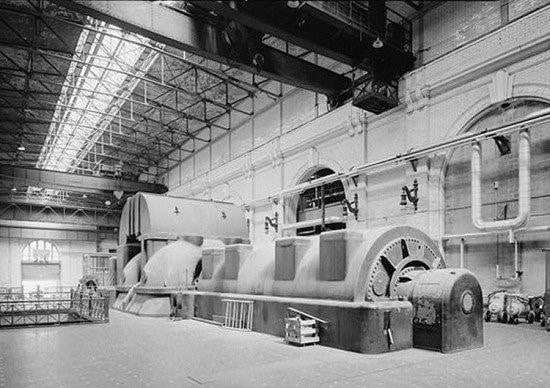

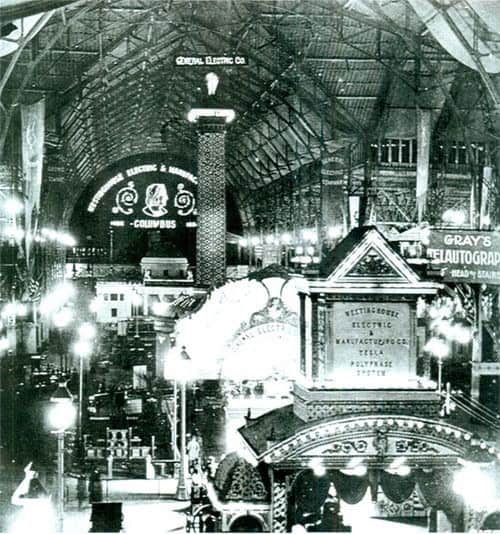
When the United States population was about sixty-five million, twenty-seven million visited the fair during its brief run. They witnessed Westinghouse’s massive machines and saw the power of electricity, at a time when well under 10 percent of American homes had electricity. No one who saw the fair left unchanged. And George Westinghouse’s fame grew.
The Great Niagara Project
For years, dreamers had desired to harness the power of Niagara Falls to power mills and factories but could not raise the money. To preserve the Falls’ natural beauty, the government had taken control of the surrounding property, and building mills there became impossible. Determined engineers designed a system of giant underground tunnels to carry the water and produce power without disturbing the natural environment, yet still could not raise the enormous funds required
In 1899, lawyer William Rankine undertook the
Unsurprisingly, Westinghouse and Tesla rose to the challenge, again outbidding General Electric (in which company Edison was no longer involved). As was his norm, George went to his best engineers and said, “Make me a generator of such and such a size,” using big numbers no one thought possible, five times the power of those at the World’s Fair, considered giants just a few years earlier. And as usual, the engineers, with Westinghouse’s prodding and ideas, came through.
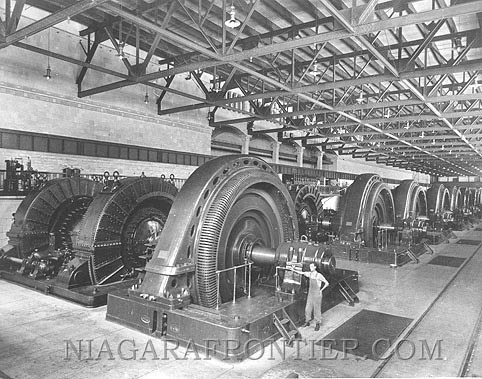
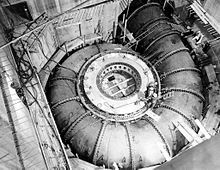
On August 26, 1895, the water began to flow through the huge turbines that turned the generators in the $4 million project. Power soon flowed to Buffalo over Tesla and Westinghouse’s long-distance AC transmission system. Heavy users of electricity, including Alcoa and many others, built plants nearby. Demand for the cheap hydroelectric power far exceeded any predictions.
George Westinghouse, twice in a decade, had enabled a new wonder of the world.
The Great Ordeal
By 1907, George Westinghouse was on top of the world, ever-inventing, always breaking records, running numerous companies employing tens of thousands. But that same year, the country experienced one of the worst economic depressions in history. Depositor runs on banks dried up available cash and credit—the bankers closed their gates and called in loans.
While the Westinghouse Air Brake Company, the Philadelphia (Gas) Company, and other entities were soundly financed, the Westinghouse Electric Company had borrowed large amounts to keep up with its tremendous growth. And it had continued to hold stocks and bonds of the power and light companies which were its customers. These securities plummeted in value.
Despite strenuous efforts to save the company and its glowing long-term prospects, this time George was unable to prevent receivership. He lost control of Westinghouse Electric to the bankers. The bankers ran Westinghouse out of the company and made public their claim that Westinghouse spent too much on overseas expansion, too much on fruitless experiments, and paid his workers too much. Yet his track record and the continuing success of his other companies belie these claims. Far more than Edison, Westinghouse had proven he could build big companies and finance and run them. His biographers say he was never quite the same after this loss, but


Even without his leadership, the Westinghouse Electric Company went on to great fame, known for the standards of quality and innovation initiated by the founder. The company continued to compete with General Electric (where Edison was also run off) for power plants around the globe. The Westinghouse brand of home appliances, radios, and televisions were found in homes throughout the land. In 1920, the company started the first commercial radio station, KDKA in Pittsburgh. Westinghouse Electric also became a major builder of elevators, escalators, and nuclear power plants.


By the 1990s, as the growth in demand for many heavy power products slowed, new management decided to entirely “reinvent” the company. Focusing on its highly profitable Group W chain of radio and television stations, Westinghouse Electric sold off all the original electrical businesses and in 1995 renamed itself CBS after purchasing the CBS television network for $5.4 billion. In 1999, Sumner Redstone, owner of Viacom, took control of this new CBS, a company worth $16 billion today. George Westinghouse’s many electrical businesses and the company’s later operations live on under new owners, including European giants ABB, Schindler, and Siemens, as well as Canada’s Bombardier and American defense company Northrop Grumman.
The End
Despite the heartbreaking loss of “his favorite child,” the electric company, George Westinghouse remained a wealthy and famous
George Westinghouse, the Man
In contrast to some of the others we have described in this “American Originals” series, including George Eastman, George Westinghouse had few hobbies or interests outside of work. From his pre-teen years until his death, he focused his mind and tremendous energy on inventing things and building companies.
Once he became convinced of an idea or path of action, he could not be swayed, even by all the experts in the world, and often by opposition from his own people. “Pig-headed” and “obsessed” would be understatements. Yet he was capable of admitting he was

Early patents of George Westinghouse
Westinghouse was a far different man from his more famous adversary, Thomas Edison. While Edison focused on products that entertained the public and drew their attention, like movies and the phonograph, Westinghouse wanted to have a massive impact on the underlying structure of society. He was more interested in providing power to factories than lights to homes, as Edison did, although Westinghouse did both. Like the railroads, he focused on the freight that served everyone rather than the passenger business that served the few who had the money to buy tickets. The World’s Fair brought publicity, but Niagara brought real power. No part of American industry was untouched by Westinghouse’s inventions. And in everything he did, he wanted the fruits to be global, opening offices around the world before other companies.

Each of the several biographies of Westinghouse mentions his amiability and friendly nature, to everyone he met. He loved people. Unlike Edison, he hated the spotlight, and avoided making speeches at all costs.
He always expected excellent, speedy work from his colleagues, but he treated them better than almost any other employer of his era. He took great pride in creating worthwhile, durable jobs for thousands.
Despite his power and wealth, he was never obsessed with profits, especially over the short term. He had confidence that if he made things that made the world a better place, the businesses would prosper. He was “purpose-driven.”
Even in the direst of crises, his optimistic spirit did not waver. He knew he was right and he believed in the future of his ideas and his companies.
While, as described above, his companies have changed hands and changed names many times, his legacies live on every time we throw on a light switch or turn on a computer. His whole life was devoted to serving society at large and serving those who worked for him. Few men in American history have had such an impact, yet been less known to the average citizen.
Sources. A great deal has been written about George Westinghouse and, especially, the Current Wars.
The most vivid, well-written history of Westinghouse, Edison, Tesla, and those wars is Empires of Light: Edison, Tesla, Westinghouse, and the Race to Electrify the World, by Jill Jonnes, published in 2003. That book is full of color and detail, yielding a great sense of all three men. It also tells the story of the world’s fair and Niagara. The Power Makers: Steam, Electricity, and the Men Who Invented Modern America by Maury Klein (2008) covers the same stories. The Electrical Manufacturers 1875–1900: A Study in Competition, Entrepreneurship, Technical Change, and Economic Growth by Harold C. Passer (1953, reprinted 1972) is an outstanding, detailed academic study of the Current Wars and earlier history of the development of electricity.
The first biography of Westinghouse was George Westinghouse: His Life and Achievements by Francis E. Leupp (1919), which gives a good feel for the man and his upbringing. This was followed in 1921 by A Life of George Westinghouse by Henry G. Prout, which focuses on the details and technologies of his endless inventions. The year 1962 saw the publication of a book for young readers, Inventive Wizard: George Westinghouse by I. E. Levine. In 2007, Pittsburgh business aficionado Quentin R. Skrabec, Jr., wrote George Westinghouse: Gentle Genius, but we found this book poorly edited. The book also reflects opinions of the author that do not always reflect the story as told by others (for example, the book casts all the blame for the 1907 loss of Westinghouse Electric on the shoulders of mean and short-sighted bankers, whereas J. P. Morgan had a history of backing innovators like Edison, and Westinghouse was enough of a businessman to know the risks of taking on large amounts of debt, which in the end cost him his company.)
In writing this too-brief summary of Westinghouse’s life, we found the Leupp,

